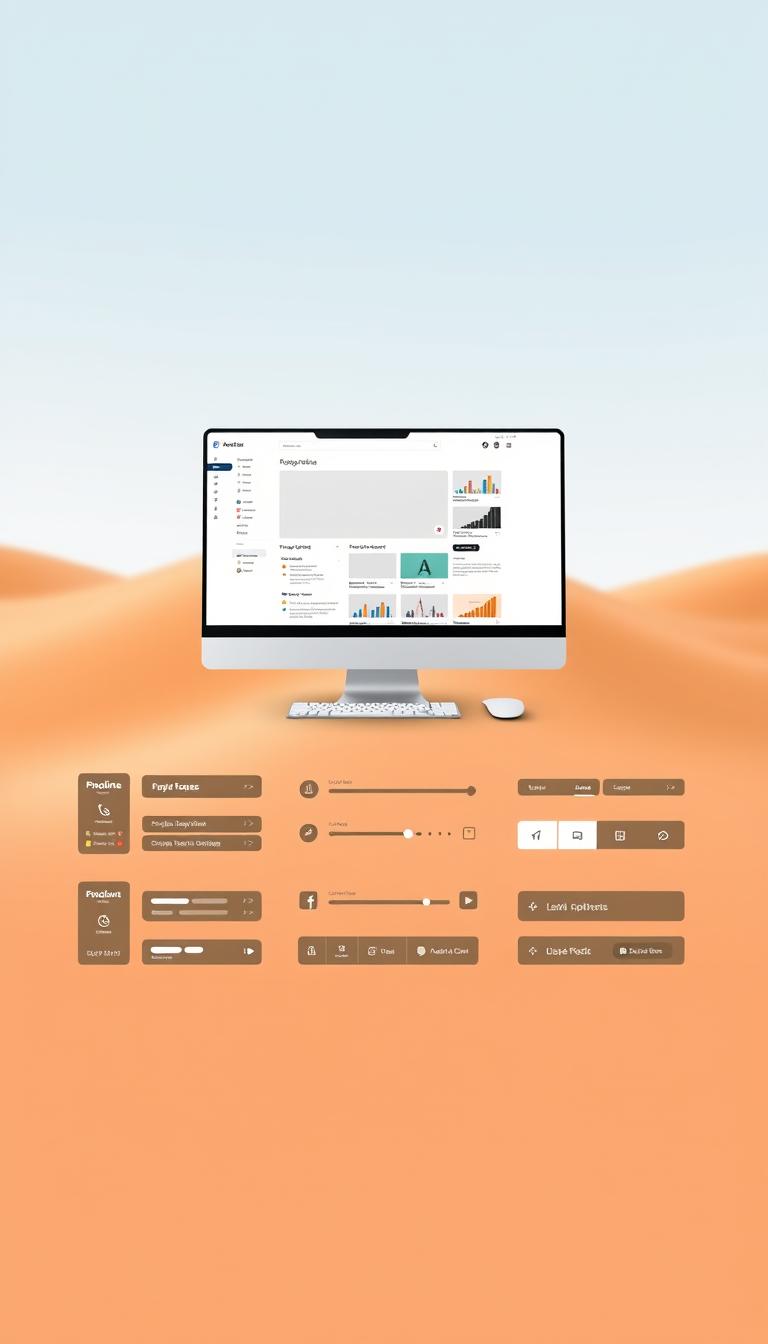
In today’s fast-paced business world, streamlining operations is key to success. We’re always searching for ways to boost productivity, efficiency, and profits. Cloud computing and Software-as-a-Service (SaaS) have changed how we do daily tasks.
Using the right digital solutions can make our workflows simpler, cut costs, and enhance performance. This article will look at the top tech solutions to help us reach our business goals and stay competitive.
Key Takeaways
- Identify the most effective digital solutions for your business needs
- Understand how technology can streamline your operations
- Discover the benefits of implementing the right software solutions
- Learn how to boost productivity and efficiency
- Explore the top software solutions for business success
Understanding the Importance of Software in Business
Businesses today need technology more than ever. They look for ways to work better, save money, and please their customers. Using software is a key strategy for these goals.
Technology has changed how businesses work. It helps them do things faster, make smarter choices, and stay competitive. The right software can automate tasks, help teams work together, and improve customer service.
The Role of Technology in Modern Enterprises
Modern businesses rely on technology to grow and innovate. Software development is key in creating solutions tailored to their needs. From ERP systems to CRM tools, technology has changed how companies operate.
Enhancing Productivity and Efficiency
Software solutions boost productivity and efficiency. They automate tasks and offer insights in real-time. For example, project management software helps teams work better, track progress, and meet deadlines.
Software also helps businesses save money and manage their budgets better. It streamlines financial tasks and gives accurate forecasts. This helps companies make smart decisions about their resources.
| Software Type | Benefits | Examples |
|---|---|---|
| Project Management | Enhanced collaboration, task automation | Trello, Asana |
| Customer Relationship Management (CRM) | Improved customer service, sales tracking | Salesforce, HubSpot |
| Accounting and Financial Software | Streamlined financial processes, accurate forecasting | QuickBooks, Xero |
Software as a Game Changer
Software has a huge impact on business operations. The right software can give companies an edge, help them grow, and make customers happier. As technology keeps changing, businesses must keep up and use new software solutions.
Understanding software’s role in business helps companies make smart tech choices. This leads to long-term success.
Types of Software Solutions for Businesses
In today’s fast-paced world, companies rely on software solutions to make things easier. These solutions meet different needs, making businesses more efficient and productive.

Project Management Software
Project management tools help teams work together better. They let businesses plan, track, and finish projects smoothly. Features include assigning tasks, setting deadlines, and checking progress.
Customer Relationship Management (CRM)
CRM systems are key for better customer relationships. They offer a place to manage customer interactions, track sales, and analyze data. This way, businesses can make customers happier and more loyal.
Accounting and Financial Software
Accounting software makes financial management easier. It has tools for invoicing, tracking expenses, and reporting finances. This helps businesses handle money better, cut down on mistakes, and follow financial rules.
Using these software solutions, businesses can tackle specific challenges and do better overall. Whether it’s managing projects, improving customer service, or handling finances, there’s a tool for it.
Benefits of Implementing Software Solutions
Technology through software is changing the game for businesses. By using digital solutions, companies see big improvements in many areas.
Increased Operational Efficiency
Software makes processes smoother, cutting down on manual work and errors. This means employees can do more important tasks. For example, project management tools help teams plan, track, and meet deadlines better.
Key benefits of increased operational efficiency include:
- Faster task completion
- Improved accuracy
- Enhanced collaboration

⭐️ Tap the exclusive deal link https://temu.to/k/uot8tcxvwum to score top-quality items at ultra-low prices. 🛍️ These unbeatable deals are only available here. Shop now and save big! ⭐️ Directly get exclusive deal in Temu app here: https://app.temu.com/m/mhb5rstagbx
Another surprise for you! Click https://temu.to/k/uag0bn0o0wd to earn with me together🤝!
Cost Savings and Budget Management
Software solutions can save a lot of money. Automated tasks mean less manual work, which cuts costs. Also, software gives insights into spending and future costs, helping with budgeting.
“The right software can help businesses save money by reducing waste, improving productivity, and enhancing financial management.”
Here’s a table showing how different software can save costs:
| Software Solution | Cost Savings | Implementation Time |
|---|---|---|
| Project Management Tool | 20% | 3 months |
| Accounting Software | 15% | 2 months |
| CRM System | 25% | 4 months |
Better Communication and Collaboration
Software makes it easier for teams to talk and work together. Tools like Slack and Microsoft Teams let teams chat in real-time. Project management software helps with task assignments and tracking.
Effective collaboration is crucial for business success. The right software ensures teams work well together, leading to better results.
Top Project Management Tools to Consider
The right project management tools can really boost team productivity and efficiency. Today, teams often work from different places. So, it’s key to have tools that help everyone work together smoothly.
Trello: Visualize Your Workflow
Trello is a visual tool for managing projects. It uses boards, lists, and cards to organize tasks. Its simple design makes it easy for teams to see how projects are going and work together.
- Create boards for different projects
- Make lists for various stages of a project
- Use cards to assign tasks to team members
Trello is loved by teams of all sizes because it’s flexible and can be customized.
Asana: Task Management Made Easy
Asana is a strong tool for managing tasks. It helps teams stay organized and meet deadlines. Users can create tasks, assign them, and set due dates.
“Asana has changed how we manage projects. It’s easy to use, powerful, and has really helped our team work better.” –
Asana offers:
| Feature | Description | Benefit |
|---|---|---|
| Task Assignment | Assign tasks to team members | Clear responsibilities |
| Deadline Setting | Set deadlines for tasks | Timely completion |
| Progress Tracking | Track the progress of tasks | Identify bottlenecks |
Monday.com: Customizable Project Tracking
Monday.com is a customizable tool for managing projects. It lets teams create workflows that fit their needs. Its flexibility and automation features are perfect for teams wanting to improve their project management.

Monday.com’s main features are customizable dashboards, automated workflows, and integrations with other tools.
Leading CRM Systems to Enhance Customer Relations
In today’s business world, the right Customer Relationship Management (CRM) system is key. It helps improve how you talk to customers and sell more. A good CRM system lets you manage customer data, track interactions, and understand customer behavior.
We’ll look at three top CRM systems that help businesses of all sizes better connect with customers.
Salesforce: Industry Leader
Salesforce is a top name in CRM, offering tools for all kinds of businesses. Its cloud-based system gives real-time customer insights. This helps businesses make smart choices and tailor their customer interactions.
HubSpot: All-in-One Solution
HubSpot CRM is a complete package that combines sales, marketing, and customer service. It’s great because it seamlessly integrates with other HubSpot tools. This makes it perfect for businesses wanting a full CRM solution.
Zoho CRM: Affordable and Feature-Rich
Zoho CRM is loved for being affordable yet packed with features. It’s a hit with small and medium-sized businesses. It has customizable workflows and integrations with third-party apps. This makes it flexible and adaptable to various business needs.
To compare these CRM systems, let’s look at their main features and prices in the table below:
| CRM System | Key Features | Pricing Model |
|---|---|---|
| Salesforce | Real-time customer insights, Sales forecasting, Marketing automation | Starting at $25/user/month |
| HubSpot CRM | Integrated sales, marketing, and customer service tools, Contact management | Free version available; paid plans start at $40/user/month |
| Zoho CRM | Customizable workflows, Sales automation, Integration with third-party apps | Starting at $12/user/month |

Knowing the strengths and costs of these top CRM systems helps businesses choose the best one for their needs and budget.
Essential Accounting Software for Small Businesses
Small businesses need accounting software to manage their finances well. The right tools can greatly improve a company’s financial health.
Accounting software offers many features. It helps with invoicing, tracking expenses, and financial reporting. These tools make managing finances easier.
QuickBooks: Comprehensive Financial Management
QuickBooks is a top choice for managing finances. It helps track income and expenses, create invoices, and manage cash flow.
Key Features of QuickBooks:
- Financial reporting and analysis
- Invoicing and billing management
- Expense tracking and management
- Payroll processing
FreshBooks: Invoicing Made Easy
FreshBooks is great for invoicing and billing. It has a user-friendly interface and strong features for managing client invoices and tracking payments.
Benefits of Using FreshBooks:
- Customizable invoices
- Automated payment reminders
- Time tracking and reporting
- Expense tracking
Xero: Online Accounting Solutions
Xero is a cloud-based accounting software. It offers features for small businesses, including real-time financial data for better decision-making.
Xero’s Key Features:
- Real-time financial reporting
- Invoicing and billing
- Inventory management
- Multi-user access
Choosing the right accounting software is crucial. Small businesses should look at their needs and what each software offers. Here’s a comparison of three popular options:
| Feature | QuickBooks | FreshBooks | Xero |
|---|---|---|---|
| Invoicing | Yes | Yes | Yes |
| Expense Tracking | Yes | Yes | Yes |
| Financial Reporting | Yes | Limited | Yes |
| Payroll Processing | Yes | No | Yes |

Choosing the right accounting software can help small businesses manage their finances better. It can also reduce costs and improve productivity.
Software for Effective Team Collaboration
In today’s fast-paced business world, collaboration tools are essential. Teams are now more distributed and work remotely. This has made effective collaboration software a must-have.
Tools like Slack, Microsoft Teams, and Google Workspace help teams communicate and work together. They make teamwork more efficient. Let’s explore some top collaboration software options.
Slack: Real-Time Communication
Slack is a top choice for collaboration. It offers real-time messaging, video calls, and file sharing. Its flexibility and customization options are why teams love it.
- Channels for organized conversations
- Direct messaging for quick queries
- Integration with numerous third-party apps
Microsoft Teams: Integrating Workspaces
Microsoft Teams is a complete collaboration platform. It works well with other Microsoft Office tools. It has many features for team collaboration.
- Channel conversations for topic-based discussions
- Meeting scheduling and video conferencing
- File storage and sharing through OneDrive
Google Workspace: Cloud-Based Collaboration
Google Workspace (formerly G Suite) is a suite of productivity tools. It lets teams collaborate in real-time. It includes Gmail, Google Drive, Docs, Sheets, and Slides.
- Real-time document editing
- Cloud storage with Google Drive
- Seamless integration with other Google apps
When picking a collaboration tool, think about your team’s needs and workflows. Each tool has unique features to boost team productivity and collaboration.

Security Software to Protect Your Business
As businesses use more digital tech, they need strong security software more than ever. Cyber threats are growing fast. It’s key for businesses to have good security to keep their data and systems safe.
Choosing the right security software helps protect your business from many cyber dangers. This includes malware, ransomware, and phishing attacks. It keeps your business’s private info safe, builds trust with customers, and meets legal rules.
Antivirus Solutions: Keeping Threats at Bay
Antivirus software is a must for any business’s security plan. It finds and removes malware like viruses and spyware. Today’s antivirus has real-time protection, automatic updates, and can spot threats early.
Firewalls: Essential Protection
Firewalls block bad traffic from the internet. They control what goes in and out of your network. Firewalls keep your network safe from cyber threats.
Data Encryption Software: Safeguarding Sensitive Information
Data encryption software is key for keeping business info safe. It makes data unreadable if it’s stolen or seen by the wrong people. This is very important for businesses with sensitive customer data or money info.
To really protect your business, use a mix of antivirus solutions, firewalls, and data encryption software. Keep these tools up to date and watch them closely to fight off new threats.

By focusing on security software and being proactive about security, businesses can lower the chance of cyber attacks and data breaches. This makes your business safer and more secure.
Evaluating Software to Meet Business Needs
To find the best software for our business, we need to look at our needs, budget, and how it will grow. Checking out software options is key to making our work smoother and more efficient.
Analyzing Requirements and Objectives
The first thing to do is figure out what our business needs. This means identifying what we need, like managing projects or keeping in touch with customers. Knowing our needs helps us pick the right software.
If we want to improve teamwork, we should look for software that helps with communication and sharing files. Tools like Slack and Microsoft Teams are great for this and can work well with other software.
Considerations for Budget and Scalability
When we’re looking at software, we must think about our budget and how it will grow. Software prices can be different, and we need to find something that fits our budget. We also need to make sure the software can grow with our business.
| Software | Cost | Scalability |
|---|---|---|
| Salesforce | $25/user/month | Highly Scalable |
| HubSpot | $40/user/month | Scalable |
| Zoho CRM | $12/user/month | Highly Scalable |
User Experience and Support
It’s also important to think about how easy the software is to use and the support it offers. A software that’s easy to use helps everyone get started faster. Good customer support is key for solving any problems that come up.
Software solutions like Trello and Asana are known for being easy to use and have lots of support, like tutorials and customer support teams.

Future Trends in Business Software
New trends are changing how businesses work, with software leading the way. As tech gets better, companies use new software to stay ahead.
Artificial Intelligence in Software Solutions
Artificial intelligence (AI) is changing business software. It offers predictive analytics and intelligent automation. AI tools can look at lots of data, helping businesses make smart choices.
AI chatbots are making customer service better. They offer real-time support and personalized experiences. This makes customers happier and helps human support agents.
| AI Application | Benefits | Examples |
|---|---|---|
| Predictive Analytics | Data-driven decision making | Salesforce Einstein |
| Intelligent Automation | Streamlined processes | Automation Anywhere |
| Customer Service Chatbots | Enhanced customer experience | IBM Watson Assistant |
Automation: Reducing Manual Tasks
Automation is a big trend in business software. It aims to cut down on manual work and make things more efficient. By automating tasks, businesses can focus on more important things.
Robotic Process Automation (RPA) tools can handle tasks like data entry and document processing. This cuts down on mistakes and boosts productivity.

Integration of Cloud Technologies
Cloud technologies are changing how businesses work. They offer scalability, flexibility, and cost savings. Cloud software lets businesses access important apps and data from anywhere.
Cloud integration also makes teamwork easier, no matter where team members are. This is great for companies with remote workers.
- Scalability: Cloud solutions can grow with your business.
- Flexibility: Access apps and data from anywhere.
- Cost Savings: Less money spent on infrastructure and upkeep.
Getting Started with Software Implementation
Starting new software is key to making our business run better. We need a detailed plan for a smooth changeover.
Developing a Strategic Implementation Plan
A good plan is essential for software success. We must look at our business needs, set goals, and plan a timeline. This way, we avoid problems and make sure the software fits our work.
Effective Training for Employees
Training is crucial for software use. We should teach our team how to use the new software well. This includes training, manuals, and ongoing help.
Measuring Success and Making Adjustments
To see if the software works for us, we need to track its success. We should watch key performance indicators, listen to feedback, and tweak as needed. This keeps the software working for our growth.






